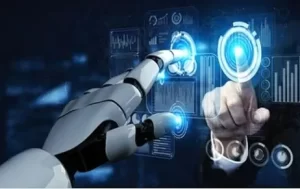Introduction What is Artificial Intelligence? Creating computer systems capable of carrying out activities that need…
Artificial Intelligence as an Inventor in Patent Law
Artificial Intelligence (hereinafter “AIs”) is a computer science discipline focused on developing machinery and systems with the ability to perform tasks attributable to human intelligence. From a patent law perspective, AIs were considered incapable of facilitating inventive processes autonomously and the permitted arena was limited to ‘AI-assisted inventions. With technological advancement, AIs can not only provide, select and test technical solutions but also go beyond the pre-defined tasks.

Stephen Thaler v. Comptroller General of Patents Trade Marks and Designs
Facts of the case
Two patent applications were filed by the Appellant disclosing a patentable invention under Section 1 of the Patents Act, 1977 (hereinafter “the 1977 Act”). Under Section 13(2), the Appellant filed a statement of inventorship identifying ‘DABUS’, the name of the Appellant’s AI machine, as the family name of the inventor. In the Amended Form submitted by the Appellant, it was made clear that the invention was “entirely and solely conceived by DABUS”.
The present appeal is the result of rejection of the two patent applications by the United Kingdom Intellectual Property Office (hereinafter “UKIPO”) on the basis of non-satisfaction of Section 13(2) of the 1977 Act.
Issue raised
The primary issue dealt with was whether the 1977 Act necessitates an ‘inventor’ to be a ‘person’, meaning a natural person or could be extended to include AIs within its ambit.
Analysis
The issue was dealt with first through a statutory perspective. The 1977 Act was referred to opine that the same has been drafted in a way which points towards the inventor being a person. Section 7 of the 1977 Act dealing with “right to apply for and obtain a patent” was deliberated upon to showcase that Section 7(2)(a) and Section 7(2)(b) deem to recognize only a person as an inventor by virtue of Section 7(2)(c) when it states, “the person or persons mentioned in paragraph (a) or (b)”.
Additionally, Section 13(1) of the aforesaid act confers a right upon the inventor or joint inventors, the same giving effect to Article 4ter of the Paris Convention for the Protection of Intellectual Property, 1883. This right was suggested to be a moral right, the right of being identified as a creator of something. Further, since only persons can have moral rights, the Section again essentially identifies an inventor to be a person.
Lord Arnold referred to Yeda Research and Development Company Ltd. v. Rhone- Poulenc Rorer International Holdings, where it was held that the 1977 Act is an exhaustive code. Sections 2(4), 8(1) and 12(1) were referred to in the above judgement identifying the inventor as a ‘person’ at various instances. Justice Elisabeth conclusively agreed with Lord Arnold while holding that a patent is in the nature of being a statutory right which can only be granted to a person. The statutory provisions under the scheme of the Act suggesting a contrary view point, DABUS was not entitled to be an ‘inventor’ under Section 7 of the Act.
At this juncture, it was noticed and that the 1977 Act was deprived of even a single reference to inventions by machines, directly or indirectly given the time of its enactment. Hence, a need to amend the statute was considered when such inventions are plausible and pragmatic in reality.
Substantiating upon the issue, it was concluded that DABUS could not be a person to whom an invention can be attributed.
Impact of the Judgement
The judgement forecasts incompatibility of the U.K. Patent Legislation with technical reality. For the mere reason that the legislators could not have foreseen such a possibility in future does not preclude an urgent need for an amendment.
Approach taken by South Africa and Australia
In South Africa, the Companies and Intellectual Property Commission did not hesitate from granting patent recognizing DABUS as the inventor and Dr. Thaler as the owner. The differentiating factor for the contrast approach was the absence of definition of “inventor” in the Patents Act, 1978 and the domestic patent system. Again, the country does not have a comprehensive patent examination process and as such patents can be granted on fulfilling minimum formalities.
In Thaler v. Commissioner of Patents, the Australian court opined that ‘inventor’ in its ordinary sense does not exclude non-humans. The court, in the above judgement, deliberated upon the uncertainty associated with recognizing the person actually responsible for the inventive process since numerous people contribute to the satisfactory outputs associated with an AI system.
The Indian Perspective
The India view-point on the subject aligns with the U.K. perspective which is against granting patents to AIs. The recourse taken to justify the view is the statutory scheme of the Indian Patents Act, 1970. Sections 2(1)(s) and 2(1)(y) indirectly refer to the inventor being a person when any passive reference is made to the same. Section 6(1)(a) reads, “An application for a patent for an invention can be made by any person claiming………” thus laying down that the ‘person’ must claim to be the first and true inventor of the invention.
In Som Prakash Rekhi v. Union of India, the Supreme Court laid down the answer to who can qualify as a legal ‘person’ in accordance with the Indian judicature. Accordingly, it was held that a jurisdictional person is someone to whom the law attributes ‘personality’. Jurisdictional personality is a legal entity who has the rights to sue and the capability to be sued by another entity. An AI does not possess the capability to use numerous rights or perform the required duties of a juristic personality independently.
The Ayyanger Committee Report of 1959 reveals the legislative intent behind the enactment of the Act. The report addresses that the very intent of mentioning the inventor for any particular patent is a matter of right of the inventor. Further, the report emphasizes that any person has a moral right of being named as an inventor even if he might not have all the legal rights over the invention. In this context, it can again be seen that AIs cannot be entitled to moral rights under the prevailing Indian laws.
Conclusion
The universal approach on the subject of AIs being ‘inventor’ of any invention is not aligned. It can be noticed that the jurisdictions wherein such applications were rejected, based their reasoning on statutory language and legislative intent of attributing moral rights. When a ruling is governed by strict statutory outlines, innovative reading in in consonance with the changing dynamics is usually restricted. While on the other hand, when technological deliberations supersede the statute, innovative thinking is facilitated. In this respect, it is pertinent that even if a ruling is unfavourable, guidelines for similar future events should be laid don recognizing the modern reality of AIs being capable to act autonomously. The Indian Patents regime also requires an amendment in this respect incorporating the law on AIs in the statutory scheme.
Author: Shailza Agarwal – a student of Symbiosis Law School (Noida), in case of any queries please contact/write back to us via email chhavi@khuranaandkhurana.com or at IIPRD.



